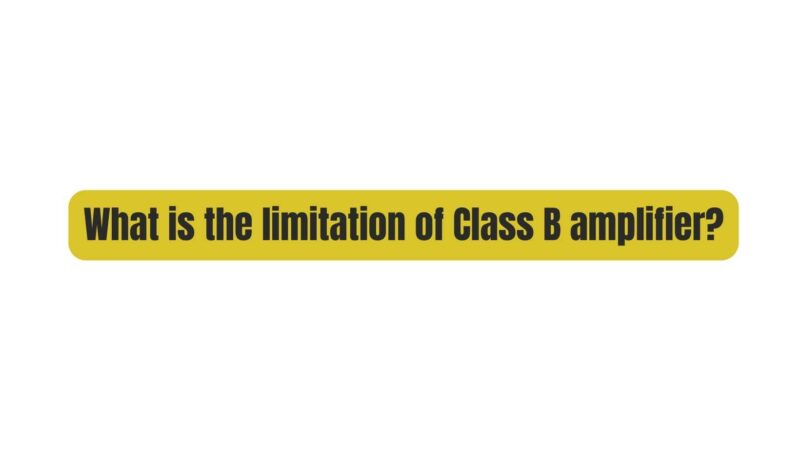Class B amplifiers, with their efficiency and ability to amplify audio signals with low distortion, have been fundamental components in audio systems and electronics for many years. However, like any technology, Class B amplifiers come with limitations that users and designers must consider. In this article, we will delve into these limitations to provide a comprehensive overview of the constraints associated with Class B amplification.
1. Crossover Distortion
One of the most notable limitations of Class B amplifiers is crossover distortion. This occurs when the input signal crosses the zero-voltage threshold, causing a momentary distortion in the output waveform. Class B amplifiers use two transistors (one for the positive half of the waveform and another for the negative half) to amplify the signal, and there is a small gap or overlap between the two transistors’ active regions where neither transistor is conducting. This gap results in a brief period of distortion, leading to what is commonly referred to as crossover distortion.
1.1. Impact on Sound Quality
Crossover distortion can negatively impact the sound quality, particularly in high-fidelity audio systems. While the distortion is generally minimal for moderate signal amplitudes, it becomes more noticeable at low signal levels. Audiophiles and professional audio engineers often prefer Class A or Class AB amplifiers for applications requiring the highest sound quality due to their lower crossover distortion.
2. Limited Efficiency
Class B amplifiers are known for their high efficiency compared to Class A amplifiers, but they still have limitations in this regard. The maximum theoretical efficiency for a Class B amplifier is 78.5%, which occurs when the output stage transistors are perfectly matched and the biasing is ideal. In practice, achieving this level of efficiency can be challenging.
2.1. Heat Dissipation
While Class B amplifiers are more efficient than Class A amplifiers, they still generate a significant amount of heat. In high-power applications, this heat can be substantial and may require additional cooling mechanisms, such as heat sinks or fans, to prevent overheating. The need for heat dissipation can add complexity and cost to the amplifier design.
3. Limited Linearity
Class B amplifiers exhibit limited linearity, particularly near the crossover point where one transistor turns off, and the other turns on. This non-linearity can result in distortion and harmonic content in the amplified signal, impacting the accuracy of signal reproduction.
3.1. Distortion at Low Signal Levels
The non-linearity of Class B amplifiers is most noticeable at low signal levels. As the input signal approaches zero, the crossover distortion becomes more pronounced. This can be a limitation in applications where accurate reproduction of low-level signals is critical.
4. Biasing Challenges
Achieving precise biasing in Class B amplifiers is essential to minimize crossover distortion and maximize efficiency. Biasing refers to the process of setting the operating point of the transistors in the amplifier. It can be challenging to maintain this biasing over various operating conditions and temperature ranges, requiring careful design and additional circuitry.
5. Limited Frequency Response
The limited frequency response of Class B amplifiers can be a concern in high-frequency applications. As the operating frequency increases, the potential for distortion and non-linearity also increases. This limitation can impact the amplifier’s suitability for applications requiring accurate amplification of high-frequency signals, such as RF (radio frequency) applications.
6. Push-Pull Configuration Requirement
Class B amplifiers typically require a push-pull configuration, which means using two complementary transistors (NPN and PNP) to handle the positive and negative halves of the input signal. This requirement adds complexity to the amplifier design and may increase manufacturing costs.
7. Size and Complexity
Compared to some other amplifier classes, Class B amplifiers can be relatively large and complex, especially when high power output is needed. The need for multiple transistors, biasing circuitry, and heat management components can result in larger and more intricate amplifier designs.
Conclusion
Class B amplifiers have been widely used for many years, primarily due to their efficiency and ability to amplify audio signals with relatively low distortion. However, they do come with limitations, including crossover distortion, limited efficiency, linearity issues, and biasing challenges. Designers and users should carefully consider these limitations when selecting Class B amplifiers for their applications and weigh them against the specific requirements of the task at hand. Advances in amplifier technology have led to the development of other classes, such as Class AB and Class D, which aim to address some of these limitations while offering efficient and high-quality audio amplification.


